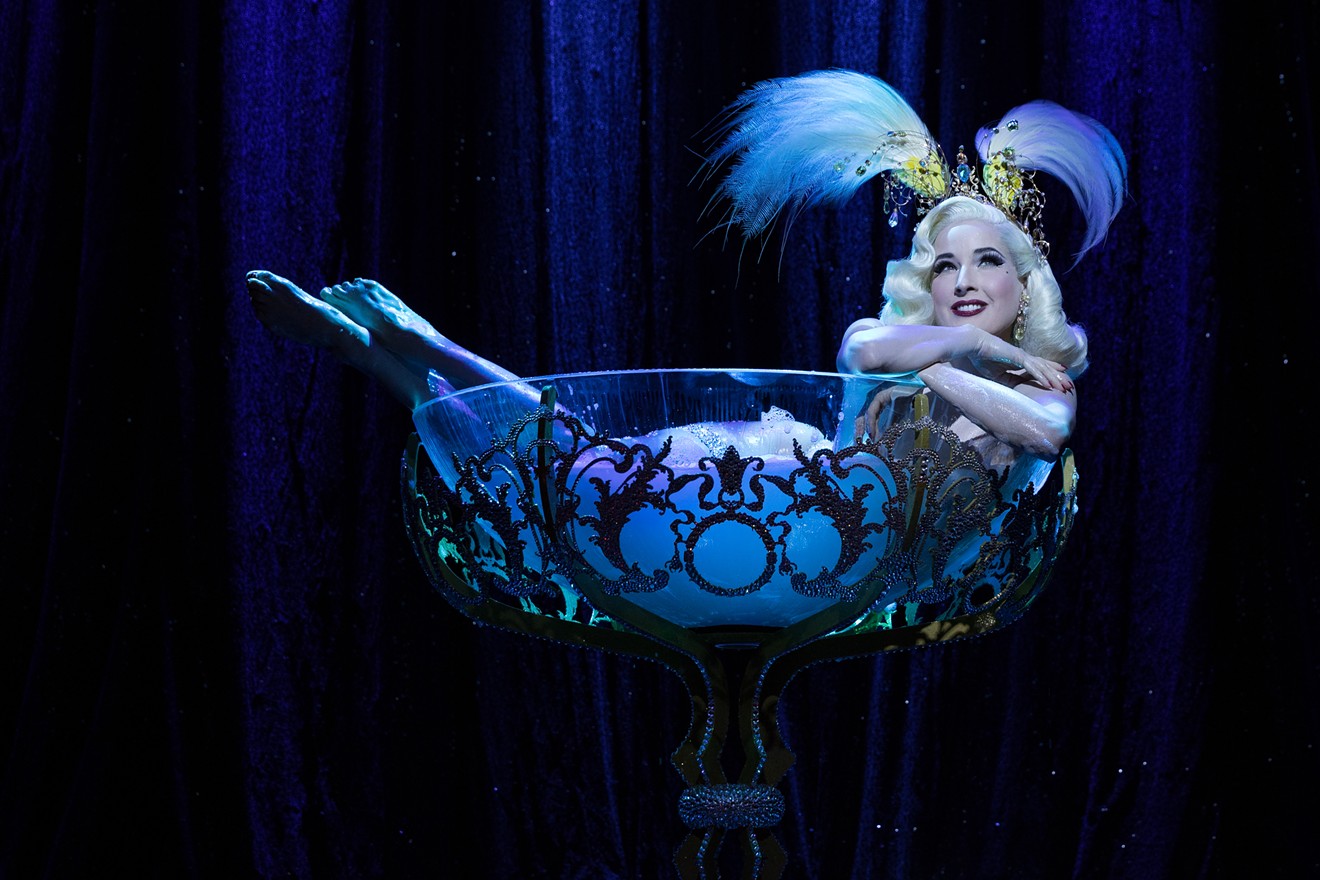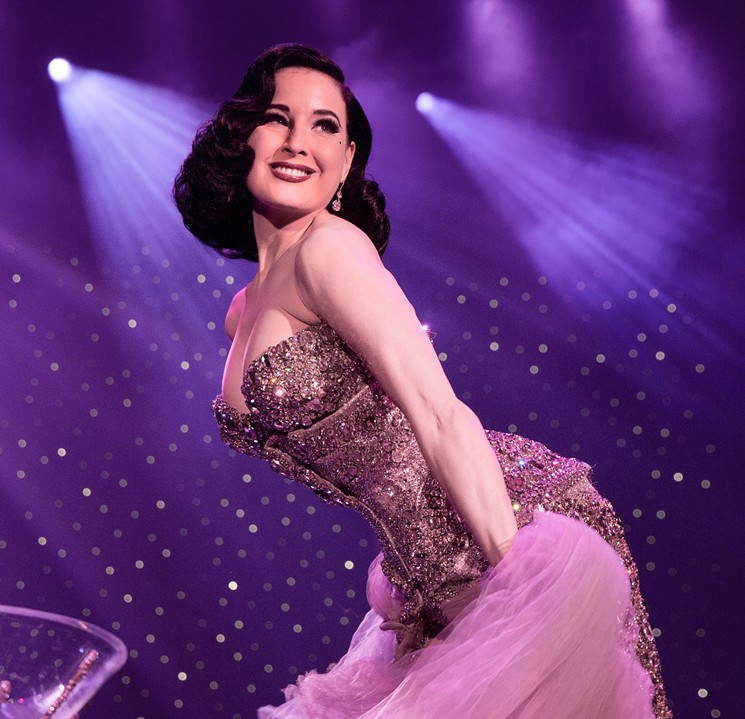Dita Von Teese is a walking, breathing time vault of a bygone era, known for her signature jet-black hair, sharp cat-eye liner, and eye-popping red lipstick that pay homage to the onscreen sirens of Hollywood's golden age of cinema and burlesque. It was a time that was great for women's fashion but not necessarily for women's rights. Unlike many people who become enamored with romanticized ideas of certain eras of the past, Von Teese maintains a modern perspective on the shortcomings of the period she so adores, transporting to the present the vintage styling of the era while parting with its societal hypocrisies and sexual repression.
"Burlesque is very different now than it was in its golden age in the 1930s and '40s, when it was typically entertainment for men," Von Teese says. "Now it's quite a diverse audience, a predominantly female audience with a very strong LGBT following."
After more than two decades as the undisputed queen of modern-day burlesque, Von Teese is once again taking her show on the road with The Art of the Teese, a two-hour spectacle featuring her classic act and support from performers she considers among the best burlesque talent in the world.
Burlesque has undergone a notable resurgence over the past decade, as society grapples with expanding understanding of gender and sexuality, and at a time when RuPaul's Drag Race is mainstream enough for primetime. Though drag and burlesque are separate art forms, they're certainly related; they both toy with expectations of gender and what it means to be female or feminine in particular. To that end, Drag Race champion and Von Teese disciple Violet Chachki joins The Art of the Teese for a handful of dates on the tour. Like the careers of Violet Chachki and the rest of the Drag Race queens, Von Teese's career was built on the power and artistry of transformation.
"You know, I'm a natural blonde from a farming town in Michigan," Von Teese says. "I'm an ordinary dishwater blonde underneath it all, but I always had big dreams of glamour, and I wanted to look like movie stars of the 1930s and '40s, and all of them underwent transformation, some of them more extreme than the other, but it's what I love about that era — that it is a created kind of beauty. I love the theater of fashion and the theater of beauty and the way we present ourselves to the world. Listen, we're all presenting ourselves in a way that is distinctive, whether it's the way we choose to wear our hair or men shaving their beard or not or growing it long. We're all making decisions for ourselves of how we want to look, and it's very difficult to say what's natural and what isn't natural."
Von Teese offers at once a glimpse into the past while pioneering the present and future. Because the fruits of her influence have affected mainstream culture in the most visible way since the early 2000s (when she graced the cover of Playboy's Christmas issue and was in a high-profile marriage to musician Marilyn Manson), it's surprising to hear she not too long ago seriously considered retirement.
"I think I started falling for the ageist mentality but also thinking like, Oh, I should have a baby, because everyone says it's so important to have a baby and have a family and raise children," she says. "I think I was starting to fall for that kind of thing, and then when I came out with my book, I was doing these book signings and I'd have hundreds of girls coming up to me for hours. I had so many people that were just discovering burlesque and came out for the first time, and they'd say, 'I'm almost old enough to see your show!' or 'I'm finally old enough to see your show!' and it made me think, Maybe I should do this again."
Von Teese sees her younger, Midwestern-blonde self in those girls. "They are girls like me that are looking for alternative role models of sensuality and beauty. That was always my purpose for doing these shows [in the first place] — for myself. I didn't feel like I had a space where I could find my confidence. I couldn't relate to anyone who was living that I felt I could be inspired by, so that's why I look to the past."
It's notable that as Von Teese brings the past to life for her predominantly female and queer audience, she creates a space of refuge away from the outside world, where thousands of people are marching through the streets demanding a return to a very different vision of the past — to a time when America was "great" for everyone except the people who sit in her audience.
"I think there's always historically been a place for escapism and glamour and fantasy throughout history. I especially love that a show like this and the kind of audience that we attract is — we have a very, I feel, like-minded audience. You can feel that you have a gathering of people that all have similar beliefs. You can feel that there is a sense of support in the room, and it's one of the things that I love about this show," she says.
"I just think I've always believed in the importance of fantasy and spectacle and glamour. There's performers that love to bring politics into their performance and have important messages that they want to convey through their work, but I'm an aesthetic aficionado, and I love to create things of beauty and fantasy and over-the-top, opulent spectacles. There are no heavy moments in the show. There are no political messages. It's just about the celebration of beauty and glamour in many different forms."
Dita Von Teese's The Art of the Teese Burlesque Revue. Friday, September 1, at the Fillmore Miami Beach, 1700 Washington Ave., Miami Beach; 305-673-7300; fillmoremb.com. Tickets cost $44 to $80 via livenation.com.
[
{
"name": "Air - MediumRectangle - Inline Content - Mobile Display Size",
"component": "19274298",
"insertPoint": "2",
"requiredCountToDisplay": "2"
},{
"name": "Editor Picks",
"component": "17482312",
"insertPoint": "4",
"requiredCountToDisplay": "1"
},{
"name": "Inline Links",
"component": "18711090",
"insertPoint": "8th",
"startingPoint": 8,
"requiredCountToDisplay": "7",
"maxInsertions": 25
},{
"name": "Air - MediumRectangle - Combo - Inline Content",
"component": "17482310",
"insertPoint": "8th",
"startingPoint": 8,
"requiredCountToDisplay": "7",
"maxInsertions": 25
},{
"name": "Inline Links",
"component": "18711090",
"insertPoint": "8th",
"startingPoint": 12,
"requiredCountToDisplay": "11",
"maxInsertions": 25
},{
"name": "Air - Leaderboard Tower - Combo - Inline Content",
"component": "17482313",
"insertPoint": "8th",
"startingPoint": 12,
"requiredCountToDisplay": "11",
"maxInsertions": 25
}
]













